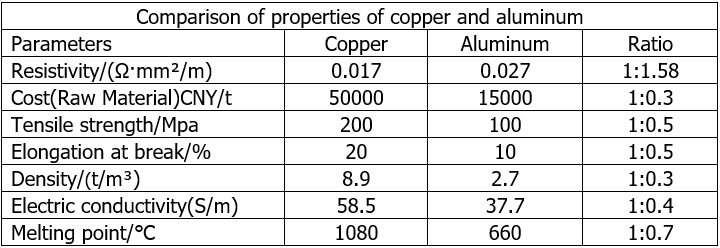Application of Aluminum Wire in Automobile Wiring Harness
-
 @
Mark Ji
@
Mark Ji
- Last updated
Table of Contents
01 Analysis on the Application of Aluminum Wire
In order to meet the requirements of lightweight automobile, some new lightweight materials have been widely used in car body, engine and other parts.
As an important part of the automobile, the wire harness accounts for 2%-3% of the total vehicle mass, and with the increase of the proportion of the automobile electrical system, the wire harness as an electrical connection system is becoming more and more complex, and its weight continues to increase.
At present, the wires used in automobile wire harness are copper conductors. In recent years, with the rising price of copper, and in order to meet the requirements of lightweight vehicles, it is imperative to find new methods and materials to replace copper wires. Compared with copper wire, aluminum wire has the advantages of light weight and low price, so aluminum wire is considered to be one of the most suitable materials to realize lightweight of automobile wire harness.
Low density
The density ratio of copper to aluminum is 10:3, compared with copper wire, the density of aluminum wire is smaller, and the weight of aluminum wire is lighter at the same length, which is one of the development trends of lightweight wire harness.

Low price and rich resources
Global copper reserves are much smaller than aluminum, so the price of copper is higher than that of aluminum, and the price of copper is on the rise, while the price of aluminum is relatively low and fluctuates little.
Automobile wire harness uses a large amount of copper, and using aluminum instead of copper can effectively reduce the production cost of automobile wire harness.
02 To solve the disadvantage of aluminum wire and realize the aluminization scheme of automobile wire harness
In view of the technical difficulties existing in the application of aluminum wire in automobile wire harness, through the continuous exploration of researchers, these technical difficulties have been overcome in recent years, thus promoting the process of lightweight of automobile wire harness.
As the most important function of the wire, the electrical conductivity of the aluminum wire is lower than that of the copper wire, which is the inherent characteristic of the aluminum conductor. in order to achieve the same current-carrying capacity as the copper wire, the only way is to increase the cross-sectional area of the aluminum wire.
The carrying capacity of aluminum wire with the same cross section is 25% lower than that of copper wire. The comparison of the current carrying capacity of the same cross-section aluminum wire and the copper wire is shown in the table below.

When copper and aluminum wires have the same current-carrying capacity, although the cross section of aluminum wires increases, their quality is still about 50% lower than that of copper wires.
It is stipulated in the QC/T29106 “Technical conditions of Automotive wiring Harness” that the terminal and the wire should be crimped firmly and should not be damaged or detached under the specified tension.
However, the low tensile strength of aluminum wire affects the crimping pull-out force of the terminal.
In order to restrain the decline of electrical conductivity of aluminum wire and improve its strength at the same time, the most effective solution is to develop new aluminum alloy wire. Sumitomo Denso Co., Ltd. has developed an aluminum alloy wire with A1-Fe-Mg as the main element, which has a tensile strength of more than 11OMPa, an elongation at break of more than 15% and a conductivity of more than 58% IACS.
This brand-new aluminum alloy wire not only makes the wire harness lightweight and ensures electrical conductivity, but also makes the wire have excellent strength, processability and impact resistance. Henan Tianhai Electric Appliance Co., Ltd. has developed a kind of automobile aluminum alloy battery wire containing Al, Fe, Cu and Mg elements. Cu can increase the resistance stability of the alloy; Fe can improve the creep resistance of the alloy and avoid the relaxation problem caused by creep; Mg can improve the contact point and have higher tensile strength under the same interfacial pressure.
1.Elimination of crimping potential difference between copper and aluminum
Different metal materials have different standard electrode potentials. If the potential difference between the metals in contact with each other is zero, then the contact metal must be the same material.

The copper-aluminum transition terminal developed to solve this problem includes a copper nose and an aluminum connecting cap. The copper-aluminum transition terminal is used to crimp the aluminum wire to eliminate the potential difference and avoid the electrochemical corrosion of copper and aluminum.
For the small wire diameter terminal products, the copper-aluminum transition terminal can not meet the diversified and complicated structural requirements of the product, so under the condition of maintaining the existing small wire diameter terminal product structure, the electrochemical corrosion of crimping between copper terminal and aluminum wire can only be solved by isolating electrolyte.
2. Direct sealing isolation electrolyte
In order to achieve the effect of isolating electrolyte in the terminal crimping part, a terminal with high air tightness and anti-corrosion structure, which is temporarily called welding cylinder terminal. The welding cylinder terminal adopts a special crimping method to make the aluminum wire in a mechanically sealed state in the pipe structure, which directly isolates the electrolyte and greatly suppresses the electrochemical corrosion of copper terminal and aluminum wire crimping.

3.Intermediate sealed isolation electrolyte
Yazaki proposed the structure of connecting aluminum wire with intermediate cap to copper terminal.
It includes terminals, intermediate caps and aluminum wires.
The terminal material is copper alloy, and the intermediate cap has conductivity, and the standard electrode potential of this metal material is between the standard electrode potential of aluminum and the standard electrode potential of copper.
By selecting different specifications of intermediate caps to fit the aluminum wires of different wire diameters, the aluminum wires are inserted into the intermediate caps, and a special crimping method is adopted to realize the mechanical connection among the terminal crimping part, the intermediate cap and the aluminum conductor. At this time, the aluminum wire is mechanically sealed in the middle cap. The use of intermediate cap not only reduces the potential difference between copper and aluminum, but also isolates the electrolyte and restrains the electrochemical corrosion of copper terminal and aluminum wire crimping.

4. Anticorrosive treatment
After the copper terminal is crimped onto the aluminum wire, the electrochemical corrosion between copper and aluminum can be solved, and the anticorrosive treatment methods include resin molding method and spraying method.
In the resin molding method, after the traditional copper terminal is crimped to the aluminum wire, the injection mold is used to make the thermoplastic resin seal the connection between the terminal crimping part and the aluminum wire, so that the terminal crimping part and the aluminum wire are isolated from the outside world as a whole.
The anticorrosive materials used in resin molding method are: polyamide resin, polyethylene resin, polypropylene resin, polyolefin resin and other organic resins.
In the spraying method, after the traditional copper terminal is crimped into the aluminum wire, a special spraying device is used to spray the liquid or paste corrosion inhibitor on the exposed aluminum wire which is not covered by the terminal crimping part, so as to isolate the aluminum wire from the outside world. It prevents moisture and electrolytes from entering the contact between the copper terminal and the aluminum wire, and inhibits the electrochemical corrosion of copper and aluminum.
The anti-corrosion materials used in the spraying method are:
1. intermediate potential metal anti-corrosion film;
2. photosensitive resin (ethoxylated phenyl acrylate, phenoxy polyethylene glycol acrylate, etc.);
3. hydrophobic corrosion inhibitor (benzotriazole with hydrophobic group, etc.).

